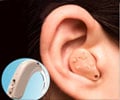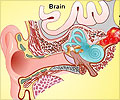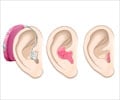According to new research, children born with a complete absence of the external ear canal, even if only one ear is affected, are more likely than their peers to struggle in school.

"Until the 1990s, any kind of hearing loss that occurred in just one ear and was present from birth was not considered a serious disability," said Judith E.C. Lieu, MD, co-author of a study that looked at the effects of aural atresia on speech development. "It was assumed that these children would adjust and develop normally. But we know now that isn't always the case."
The research is published July 18 in JAMA Otolaryngology.
Aural atresia occurs in about one of 10,000 live births. In two-thirds of cases, only one ear-more commonly the right ear-is affected. The condition is almost always accompanied by a malformed or absent external ear.
Because ears affected by atresia lack an ear canal, sound is not conducted to the inner ear, which in most cases is healthy. Children born with unilateral atresia may have completely normal hearing in their other ear. A number of surgical and amplification techniques that enable sound to reach the inner ear can restore hearing for this condition.
Many of these children, however, do not use devices that would enable hearing with both ears. "There are cost issues, comfort issues and vanity issues behind this," said Lieu. "And society has a long history of believing that one good ear is sufficient."
Advertisement
Armed with recent studies indicating that children with unilateral hearing loss from causes other than atresia have an increased risk of speech and language delays that can affect school performance, Lieu and her colleagues at Washington University School of Medicine set out to determine if the same was true for children with aural atresia.
Advertisement
Nearly all children with the condition had a moderately severe hearing loss in their affected ears. And those with atresia in only one ear had normal hearing in their other healthy ear. Of note is that all children with atresia in both ears wore two hearing aids, but fewer than 5 percent children with atresia in one ear had received a hearing aid.
As part of the study, the investigators analyzed data from speech pathologists evaluations and from clinic notes by psychologists and nurses, and parental reports to evaluate rates of speech or language delays, prevalence of speech therapy and educational interventions.
The data showed that in children with unilateral atresia, about 40 percent required speech therapy and 25 percent experienced difficulties learning in school.
As expected, children with atresia of both ears had received speech therapy, and none of these children had any academic performance issues. "This may be because their impairment was more fully appreciated and addressed, and their learning environment was modified," said Lieu.
Compared with children who have atresia of the left ear, those with the condition on the right may be more likely to have problems learning in school. In previously published studies, nearly 35 percent of those with right unilateral hearing loss had repeated a grade, compared with fewer than seven percent of children with left unilateral hearing loss.
Based on their findings, the investigators advocate close, early and ongoing monitoring of children with unilateral aural atresia for early signs of speech or academic struggles and adoption of a low threshold for interventions.
"There are bone-anchored devices and bone-conduction hearing aids that can either restore hearing or make it significantly better," Lieu said. "Even if parents do not choose these options, or children refuse to wear them, teachers, parents and physicians should be vigilant about watching for signs of language delays and school problems and attempt to understand the root cause."
Source-Newswise













